APAC Ready to Eat Food Market Size
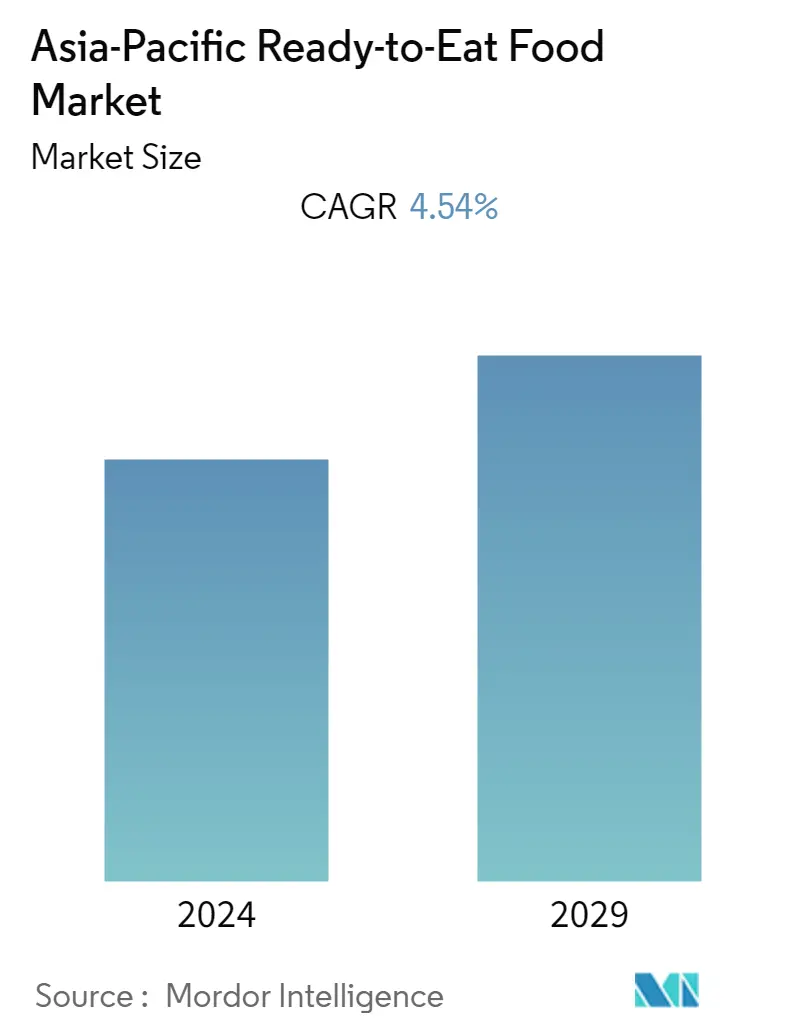
| Study Period | 2019 - 2029 |
| Base Year For Estimation | 2023 |
| Forecast Data Period | 2024 - 2029 |
| Historical Data Period | 2019 - 2022 |
| CAGR | 4.54 % |
| Market Concentration | Low |
Major Players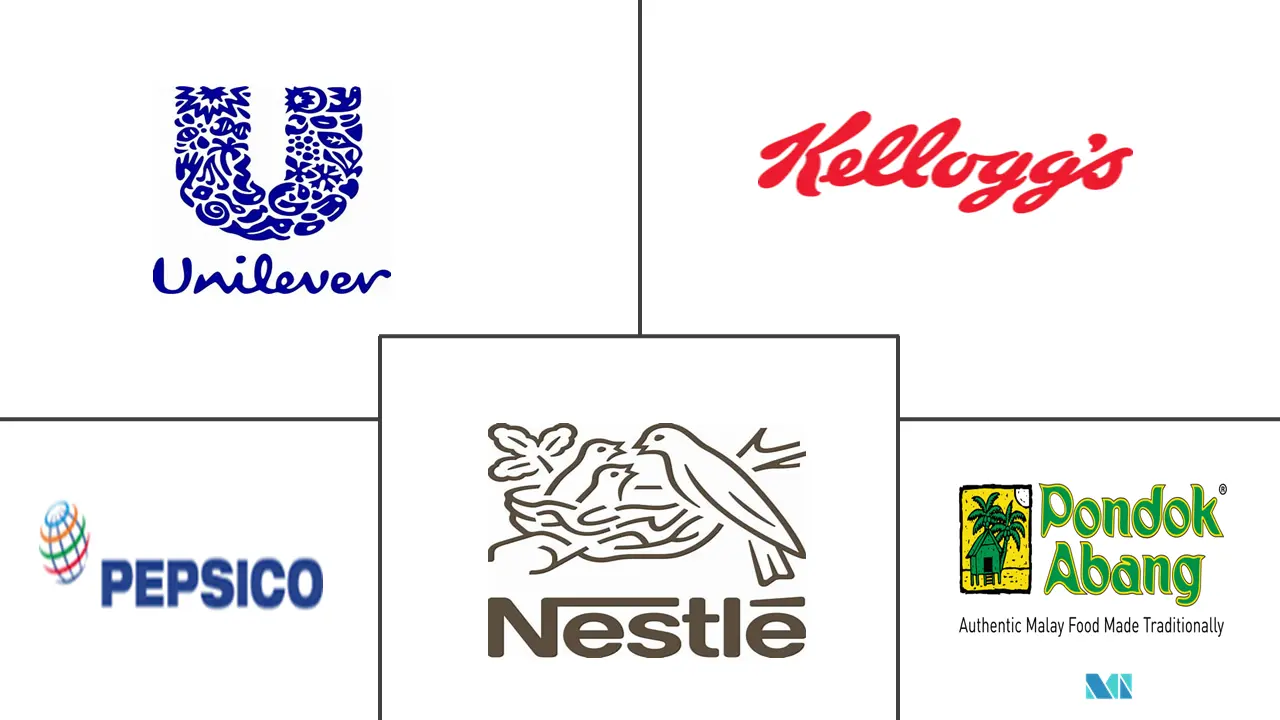
*Disclaimer: Major Players sorted in no particular order |
APAC Ready to Eat Food Market Analysis
The Asia-Pacific ready-to-eat food market was valued at USD 126.87 billion for the current year and is projected to register a CAGR of 4.54% over the next five years.
- The ready-to-eat-food market is experiencing significant growth. As a result of the new hybrid working patterns and hectic consumer lifestyles point to a larger number of frozen ready meals being consumed in the foreseeable future. Due to fast-paced lifestyles, the need for a quick meal or snack among adults has been driving the demand for healthy and convenient food that can be consumed instantly. Frozen food products are considered beneficial as they can be cooked within less time for consumption. These factors have been propelling the market growth. The ready-to-eat-food market is driven by the increasing demand for convenience and healthy food options.
- Additionally, the trend towards more plant-based/vegan ingredients and the use of sustainable packaging with less plastic and waste is continuing to change the way packaged food boxes are perceived overall. Therefore, brands are under more pressure to provide better products for the environment. For instance, in May 2022, Plix announced its plans to expand its product portfolio by launching its plant-based snackable functional foods in India. The company claims that the Plix'ssnackable useful food range includes High Protein Peanut Butter With 25G Plant Protein & Superfoods, Lean Fudge Bar Chocolate 5G Protein, Brain Fudge Bar Mocha Fudge 5G Protein, and Skin Fudge Bar Berry Blast with 5G Protein. All of its products claim to be plant-based, chemical and preservative-free products. Therefore, sustainable Ready-to-Eat Food products further drive the market in this region.
APAC Ready to Eat Food Market Trends
Rising Demand For Ready Meals Food Products to Influence Growth
- The convenience offered by ready-to-eat meals has been a significant driver of their growth in popularity, as they save time and require minimal effort to prepare. Additionally, an increasing number of individuals, particularly working professionals and students, prefer these products over restaurant meals due to the money saved and the fact that they only need to be heated before consumption.
- However, the popularity of packaged foods and ready-to-eat meals has also led to concerns about their taste and nutritional value. In recent years, the packaged food industry has evolved to offer better quality food options with simpler preparation methods, contributing to the market's growth for ready-to-eat meals. Several Indian companies, including MTR, Gits, Haldiram, and Bikano, are also trying to tap into the food industry's potential by improving the quality of their products and expanding their utility.
- Quick commerce, or q-commerce, is a significant driver of the growth in sales of ready meals. Local delivery service players have been quick to meet the growing demand for fast and convenient delivery of small quantities of goods to customers. Additionally, consumers cannot travel freely, so they are more willing to explore different cuisines and flavors, including ethnic and exotic tastes. The growing awareness and adoption of global trends have also contributed to the popularity of plant-based foods, including ready meals, which have gained a recognizable niche market.
- For instance, in April 2023, Float Foods, a pioneer in plant-based food technology and innovation, announced the launch of its two latest products at the Food & Hotel Asia (FHA) exhibition at the Singapore Expo. The new product launch includes Asia's first plant-based poached egg and plant-based yolk. Hence, these factors positively affect the market in the Asia-Pacific region.
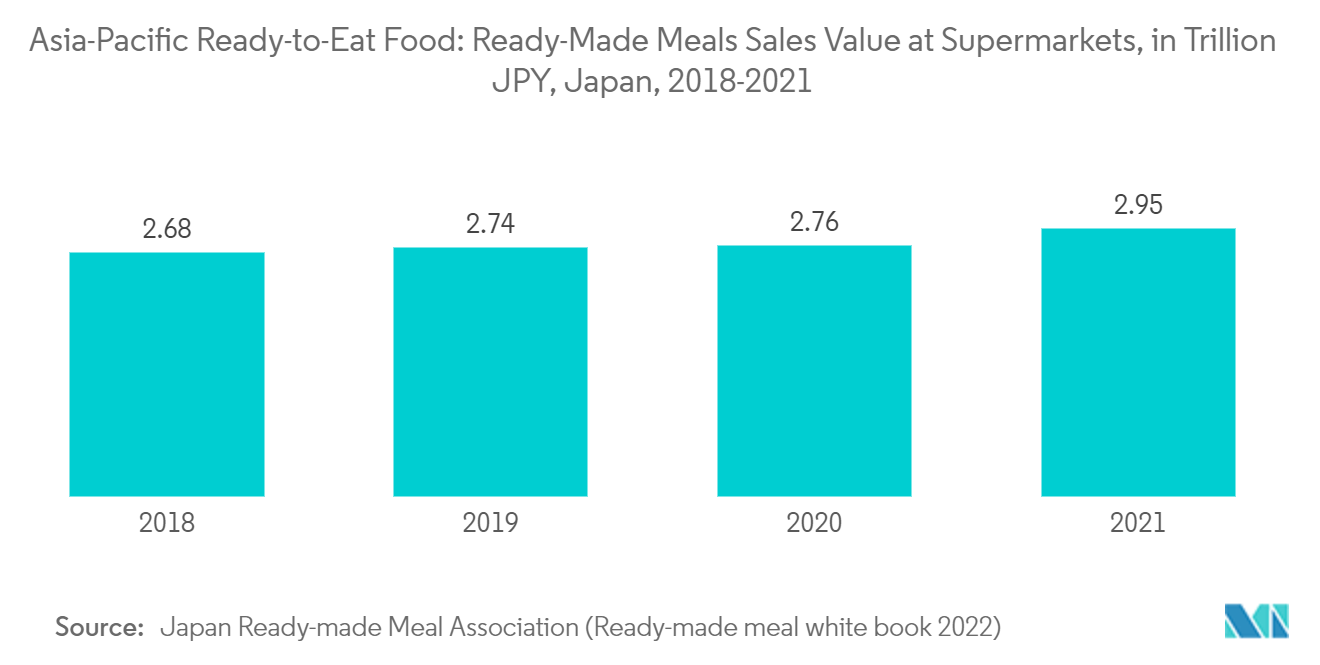
India holds Major Share in the Asia-Pacific Region
- The popularity of convenient foods has significantly increased in recent times, particularly among working-class people, teenagers, hostel residents, and bachelors. As a result, manufacturers are continuously launching innovative products to meet the consumer's needs. For instance, in March 2021, Hyderabad-based Instahot Foods Private Limited launched The Taste Company (TTC) brand, which offers a delectable menu of ready-to-eat Indian food products for breakfast as well as meals.
- The company claims that it is the first brand in the country to offer non-vegetarian varieties, including chicken rice, in the instant food category. Further, the company also announced its plans to launch its two new ready-to-eat food products, including chicken biryani and Gongura chicken biryani.
- Moreover, hypermarkets and supermarkets are the primary distribution channels for RTE food in India. The wider availability of products under one roof, ranging from soup to ready-to-eat food products, has fueled the growth in the sales channel. Supermarkets sell products at competitive prices and offer discounts to expand their consumer base. However, despite the growing demand for convenience on-the-go snack food in the market, some consumers are more health-conscious.
- The rising prevalence of lifestyle disorders such as atherosclerosis, stroke, diabetes, and obesity has increased the inclination toward healthy snack products such as nuts, fruit snacks, snack bars, and other confectionery snack products. Therefore, all the above-mentioned factors drive the Ready-to-eat food market across the country.
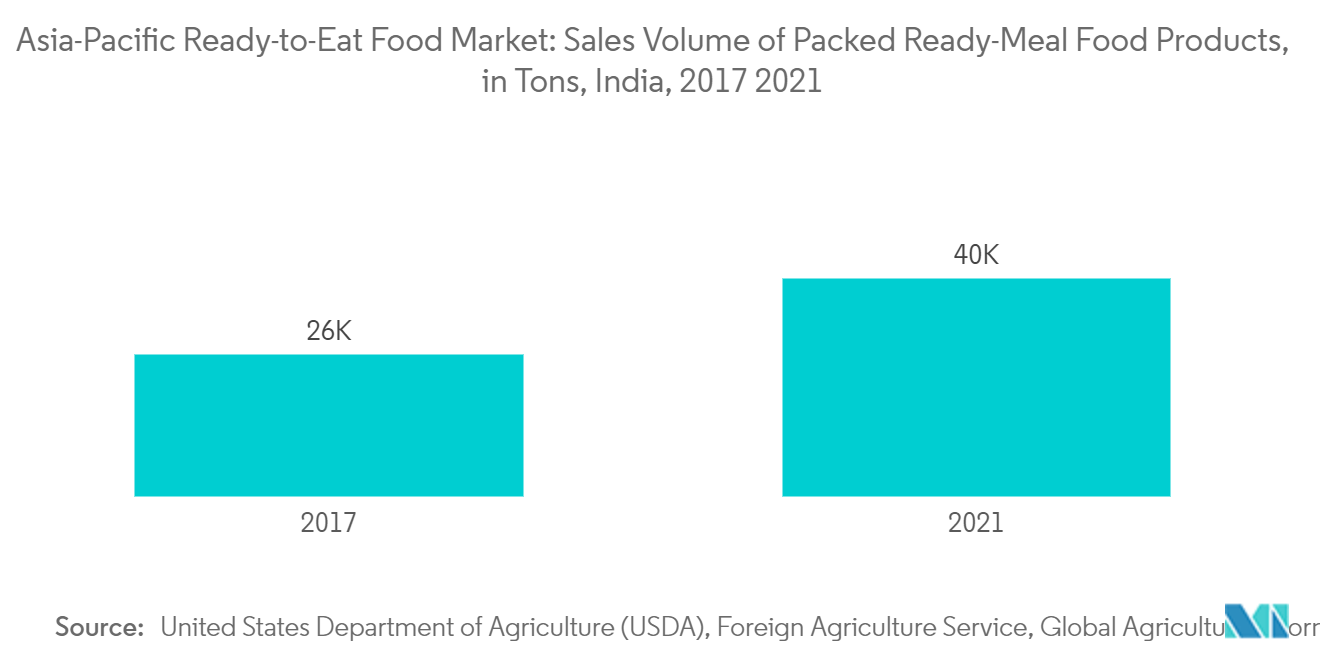
APAC Ready to Eat Food Industry Overview
The Asia-Pacific market for ready-to-eat food is highly competitive, with numerous domestic and multinational players vying for a larger share of the market. The key players are adopting strategic approaches such as mergers, acquisitions, partnerships, and expansions, as well as focusing on new product development to enhance their brand presence among consumers. The leading companies dominating the regional market include PepsiCo Inc., Nestlé, Kellogg's Company, Pondok Abang, and Unilever, among others. Further, the companies have been introducing new and innovative products with the inclusion of naturally derived ingredients so as to make their product unique from the existing products. Owing to the rapidly developing nature of the market, new product innovation has become the most commonly used strategy among all, as it helps in understanding the changing needs of the consumers in the market.
APAC Ready to Eat Food Market Leaders
-
PepsiCo Inc.
-
Pondok Abang
-
Nestlé S.A.
-
Unilever PLC
-
The Kellogg's Company
*Disclaimer: Major Players sorted in no particular order
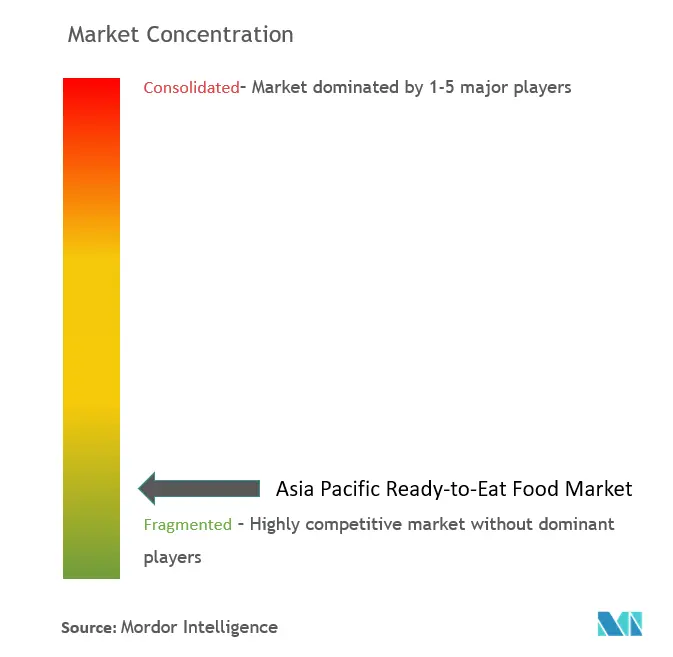
APAC Ready to Eat Food Market News
- March 2023: Goeld, a prominent frozen food company in India, unveiled its latest product lineup, now available at Reliance Retail stores nationwide. The newly introduced range of frozen food offerings includes Pizza Pockets, Paneer Pakodas, and Idlis.
- February 2023: The Korean food giant Pulmuone revealed its partnership with the United States-based food-tech company Yokai Express to launch innovative vending machines capable of preparing instant meals. Additionally, Pulmuone asserts that Yokai Express' vending machines are operational at various subway stations throughout Japan.
- February 2023: Delfrez, a leading omnichannel poultry brand in India, introduced an exciting array of ready-to-eat snack alternatives such as Momos, Tikka, Kebabs, and Gravy. The company proudly claims that this fresh range of ready-to-eat snacks is completely free from antibiotics, steroids, preservatives, and artificial additives.
- January 2023: Beyond Meat, Inc. joined forces with Fresh Kitchen, a wholly-owned brand of the prominent freshly prepared food provider Bakkavor China, to launch ready-to-eat (RTE) meals featuring Beyond Meat's plant-based meat products in the region. Together, these two brands are introducing a new line of convenient RTE meals designed for consumption at home or on the go.
APAC Ready to Eat Food Market Report - Table of Contents
1. INTRODUCTION
- 1.1 Study Assumptions and Market Definition
- 1.2 Scope of the Study
2. RESEARCH METHODOLOGY
3. EXECUTIVE SUMMARY
4. MARKET DYNAMICS
-
4.1 Market Drivers
- 4.1.1 Rising Demand For Ready Meals Food Products to Influence Growth
- 4.1.2 Increasing Demand for Organic and Vegan Ready-to-Eat food products.
-
4.2 Market Restraints
- 4.2.1 Rising Concern Over Health Issues Associated with Processed Foods
-
4.3 Porter's Five Forces Analysis
- 4.3.1 Threat of New Entrants
- 4.3.2 Bargaining Power of Buyers/Consumers
- 4.3.3 Bargaining Power of Suppliers
- 4.3.4 Threat of Substitute Products
- 4.3.5 Intensity of Competitive Rivalry
5. MARKET SEGMENTATION
-
5.1 Product Type
- 5.1.1 Instant Breakfast/Cereals
- 5.1.2 Instant Soups and Snacks
- 5.1.3 Ready Meals
- 5.1.4 Baked Goods
- 5.1.5 Meat Products
- 5.1.6 Other Product Types
-
5.2 Distribution Channel
- 5.2.1 Supermarkets/Hypermarkets
- 5.2.2 Convenience/Grocery Stores
- 5.2.3 Speciality Stores
- 5.2.4 Online Retail Stores
- 5.2.5 Other Distribution Channels
-
5.3 Country
- 5.3.1 China
- 5.3.2 Japan
- 5.3.3 Australia
- 5.3.4 India
- 5.3.5 Rest of Asia-Pacific
6. COMPETITIVE LANDSCAPE
- 6.1 Most Adopted Strategies
- 6.2 Market Share Analysis
-
6.3 Company Profiles
- 6.3.1 PepsiCo Inc.
- 6.3.2 Nestlé S.A.
- 6.3.3 The Kellogg's Company
- 6.3.4 Pondok Abang
- 6.3.5 Unilever PLC
- 6.3.6 McCain Foods Limited
- 6.3.7 General Mills Inc.
- 6.3.8 YO-KAI EXPRESS
- 6.3.9 GOEL Group
- 6.3.10 Beyond Meat, Inc.
- *List Not Exhaustive
7. MARKET OPPORTUNITIES AND FUTURE TRENDS
** Subject To AvailablityAPAC Ready to Eat Food Industry Segmentation
Ready-to-eat foods are made for direct consumption and do not require much further processing. They are mostly consumed without prior preparation or cooking.
The Asia-Pacific ready-to-eat food market is segmented by product type, distribution channel, and country. By product type, the market is segmented by instant breakfast/cereals, instant soups and snacks, ready meals, baked goods, meat products, and other product types. Based on distribution channels, the market is segmented by supermarkets/hypermarkets, convenience/grocery stores, specialty stores, online retail stores, and other distribution channels. By geography, the market is segmented by China, Japan, India, Australia, and the rest of the Asia-Pacific.
The market sizing has been done in value terms in USD for all the abovementioned segments.
| Product Type | Instant Breakfast/Cereals |
| Instant Soups and Snacks | |
| Ready Meals | |
| Baked Goods | |
| Meat Products | |
| Other Product Types | |
| Distribution Channel | Supermarkets/Hypermarkets |
| Convenience/Grocery Stores | |
| Speciality Stores | |
| Online Retail Stores | |
| Other Distribution Channels | |
| Country | China |
| Japan | |
| Australia | |
| India | |
| Rest of Asia-Pacific |
APAC Ready to Eat Food Market Research FAQs
What is the current Asia-Pacific Ready-to-Eat Food Market size?
The Asia-Pacific Ready-to-Eat Food Market is projected to register a CAGR of 4.54% during the forecast period (2024-2029)
Who are the key players in Asia-Pacific Ready-to-Eat Food Market?
PepsiCo Inc., Pondok Abang, Nestlé S.A., Unilever PLC and The Kellogg's Company are the major companies operating in the Asia-Pacific Ready-to-Eat Food Market.
What years does this Asia-Pacific Ready-to-Eat Food Market cover?
The report covers the Asia-Pacific Ready-to-Eat Food Market historical market size for years: 2019, 2020, 2021, 2022 and 2023. The report also forecasts the Asia-Pacific Ready-to-Eat Food Market size for years: 2024, 2025, 2026, 2027, 2028 and 2029.
APAC Ready to Eat Food Industry Report
Statistics for the 2024 APAC Ready to Eat Food market share, size and revenue growth rate, created by Mordor Intelligence™ Industry Reports. APAC Ready to Eat Food analysis includes a market forecast outlook to 2029 and historical overview. Get a sample of this industry analysis as a free report PDF download.



